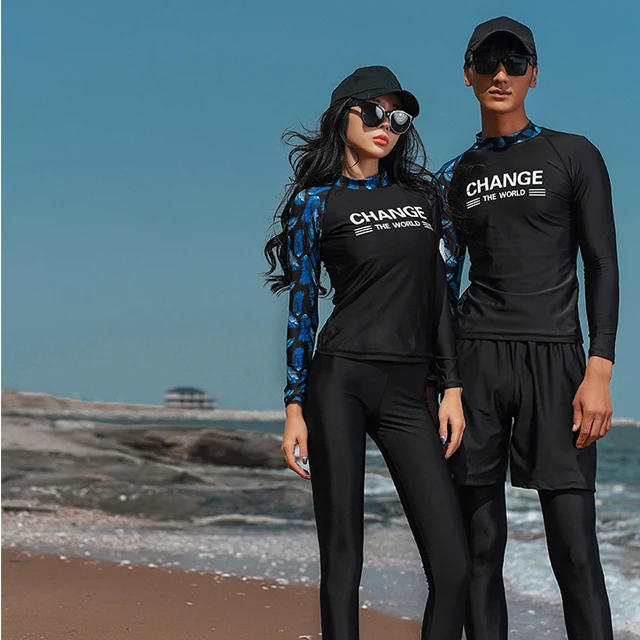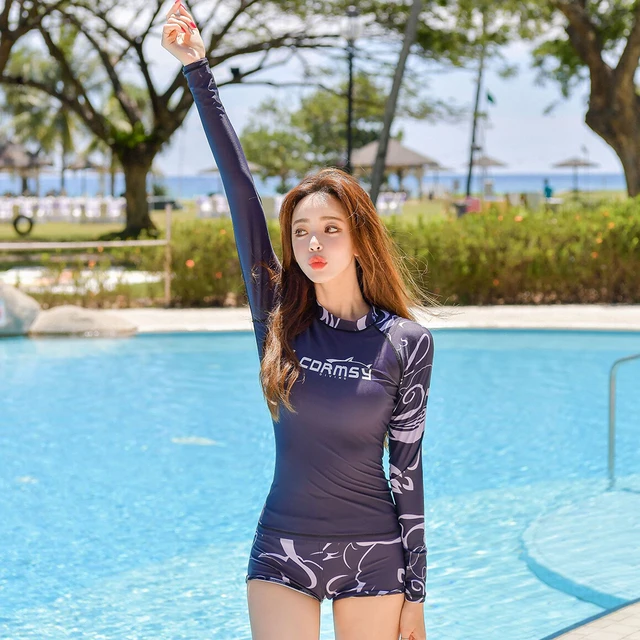
The latest trends in women’s swim shirts for sun protection reflect a fusion of functionality and fashion, prioritizing both style and skin health.
Here are some key trends:
Longer Lengths and High Necklines:
Swim shirts featuring longer lengths that extend past the waist and high necklines provide enhanced coverage against harmful UV rays. These styles often come with built-in thumbholes to ensure sleeves stay in place during water activities.
Rash Guards with Modern Prints and Patterns:
Rash guards have evolved from basic solids to incorporate vibrant prints, patterns, and designs. From tropical florals to geometric shapes, these pieces add a pop of color and fun to beachwear while still providing UPF 50+ protection.
Sustainable Fabrics:
A growing trend is eco-friendly swimwear, including swim shirts made from recycled materials such as nylon or polyester from post-consumer waste, which can also offer UV protection.
Convertible Designs:
Innovative designs include swim shirts that can be worn multiple ways – as a full shirt, cropped top, or tied around the waist, offering versatility and allowing wearers to adjust their coverage according to the intensity of the sun.
Integrated Swimwear Sets:
Matching swim shirts with bikini bottoms or one-piece swimsuits create a cohesive look and provide full-body sun protection. Some sets feature coordinating cover-ups that double as swim shirts.
Athleisure-Inspired Swim Shirts:
With the rise of athleisure, athletic-style swim shirts are gaining popularity. They’re designed to mimic sports bras or tank tops but are made from quick-drying, moisture-wicking fabrics that protect against UV radiation.
In conclusion, women’s swim shirts have become an integral part of summer wardrobes, combining technology and aesthetics to ensure that sun safety doesn’t compromise style.
As designers continue to innovate, we can expect to see more advanced features like adjustable hems, breathable mesh panels, and even integrated SPF technologies in future swim shirt designs.

Choosing the perfect fit and style for a women’s rash guard swim shirt involves considering multiple factors to ensure both comfort, functionality, and fashion-forwardness.
Here are some key steps to guide you through the process:
Understanding Your Needs:
Purpose:
Determine whether you primarily need a rash guard for sun protection, warmth in cooler waters, or as a surf or water sports gear that provides coverage against abrasions.
UPF Rating:
Look for shirts with a high Ultraviolet Protection Factor (UPF) rating, which indicates how much of the sun’s UV radiation is absorbed by the fabric.
Fit and Comfort:
Size and Cut:
Choose a rash guard that fits snugly but not too tight, allowing for full range of motion. Opt for a tailored fit to avoid flapping fabric during activities. Also consider sleeve length; long sleeves provide more coverage while short sleeves can be cooler.
Stretch and Flexibility:
Ensure the material has sufficient stretch, typically made from nylon and spandex blends, to move comfortably with your body without feeling restrictive.
Style Considerations:
Colors and Patterns:
Choose colors and patterns that match your personal style and complement your existing swimwear. Bold prints can make a statement, while solid colors offer versatility.
Design Elements:
Some rash guards come with zippers for adjustable ventilation, hoods for extra sun protection, or even integrated bras for added support. Assess these features based on your preferences.
Quality and Durability:
Material Quality:
Invest in rash guards made from high-quality materials designed to withstand chlorine, saltwater, and sun exposure. Quick-drying properties are also beneficial.
Seams and Stitching:
Flatlock seams are ideal to prevent chafing and irritation. Double-stitching ensures durability over time.
Try Before You Buy:
Trial Fit:
If possible, try the rash guard on before purchasing to check its fit across the chest, shoulders, arms, and waist. It should feel comfortable and stay in place during movement.
Layering:
Consider how it will layer under or over other swimwear pieces and if it aligns with your overall beach or poolside look.
By carefully evaluating these aspects, you’ll be able to find a women’s rash guard swim shirt that not only offers the necessary protection but also complements your style and enhances your aquatic experience.

Introduction:
Women’s swim shirts, also known as rash guards or sun protection shirts, have evolved beyond being a mere beach accessory to become an integral part of aquatic sports attire.
They serve dual purposes – offering significant UV protection from the harmful effects of the sun and improving performance in water-based activities.
UV Protection:
The first critical role these shirts play is in safeguarding the skin from sun damage.
Made with UPF (Ultraviolet Protection Factor) materials, they block or absorb a substantial amount of both UVA and UVB rays that can lead to sunburns, premature aging, and even skin cancer.
The high UPF ratings (often 50+), ensure that only a tiny percentage of UV radiation penetrates through the fabric to reach the skin, making them ideal for prolonged outdoor exposure during swimming, snorkeling, or simply lounging by the pool.
Aquatic Sports Performance:
Beyond sun protection, women’s swim shirts contribute significantly to athletic performance.
Designed with lightweight, quick-drying, and moisture-wicking fabrics such as nylon and spandex blends, they minimize drag in the water, allowing for ease of movement and increased speed.
These materials are also chlorine-resistant and retain their shape over time, ensuring durability for regular use in pool training or competitive events.
Moreover, the snug, but comfortable fit of swim shirts reduces friction against the water, which can be particularly beneficial in activities like surfing, where maintaining body control is crucial.
Some designs also include compression features that can support muscles, reduce fatigue, and enhance recovery post-exercise.
Versatility and Style:
Swim shirts often come in long-sleeved or short-sleeved options, providing varying levels of coverage depending on individual preferences and environmental conditions.
They can be paired with swim shorts, leggings, or bikini bottoms to create versatile outfits suitable for various aquatic sports and activities.
In conclusion, women’s swim shirts have become a staple in the world of aquatic sports not just for their health benefits but also for their contribution to performance enhancement.
As more people recognize the importance of sun safety and the advantages of advanced sportswear technology
These garments continue to grow in popularity among professional athletes and casual swimmers alike.

The influence of fabric technology on the design and functionality of women’s swim shirts is significant, impacting not just how they look but also their performance, comfort, and protection.
Here are several ways fabric technology has evolved to shape modern swim shirt designs:
UV Protection:
Advanced fabrics such as UPF (Ultraviolet Protection Factor) materials have revolutionized swimwear by offering built-in sun protection.
These fabrics block harmful UV rays, ensuring that women’s swim shirts not only cover skin but also shield it from potential sun damage.
This feature allows for longer hours in the sun while minimizing health risks.
Moisture Wicking:
Technological advancements in textiles have led to the development of moisture-wicking fabrics that draw sweat away from the skin to the outer surface of the shirt, where it can evaporate quickly.
This keeps wearers cool and dry, making swim shirts more comfortable and functional during water activities or under the heat of the sun.
Quick-Drying Properties:
High-tech microfibers used in swim shirts are designed to dry rapidly after getting wet.
This means less time spent feeling soggy and more time enjoying the water or other activities, enhancing the overall user experience.
Chlorine Resistance:
Swim-specific fabrics are engineered to withstand the harsh effects of chlorine, preventing premature fading, degradation, and stretching.
This ensures a longer lifespan for swim shirts and maintains their shape even after multiple uses in chlorinated pools.
Stretch and Flexibility:
The use of spandex, elastane, and other stretchy materials provide flexibility and a snug fit that moves with the body, allowing for greater freedom of movement in water sports and providing a flattering silhouette.
Innovative Designs:
With improved textile capabilities, designers can create unique patterns, cuts, and styles that wouldn’t be possible with traditional materials.
For example, seamless construction, breathable mesh inserts, and compression elements for muscle support are all enabled by advanced fabric technologies.
Eco-Friendly Fabrics:
New sustainable fabric technologies have paved the way for environmentally conscious swim shirts made from recycled plastics, organic cotton, or plant-based fibers.
These materials often retain high-performance properties while reducing environmental impact.
In summary, fabric technology plays an integral role in shaping the design and functionality of women’s swim shirts, influencing everything from their protective features to their aesthetic appeal and sustainability, ultimately transforming them into versatile and high-performance pieces of clothing suitable for various aquatic activities and conditions.
